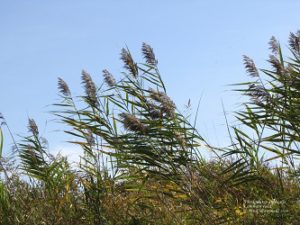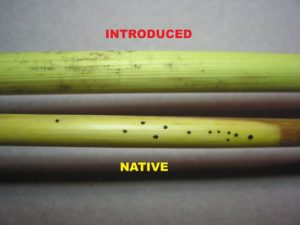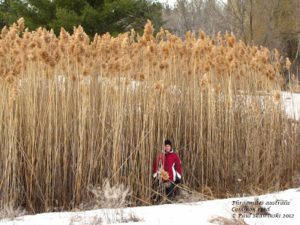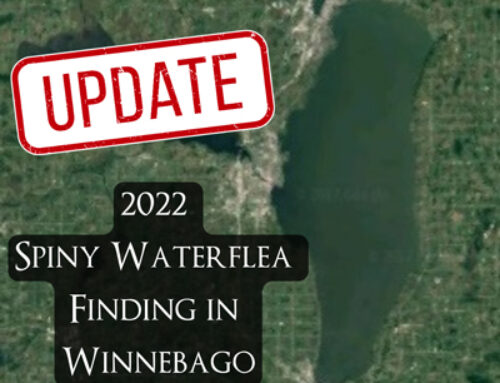Common Reed/Phragmites (Phragmites australis ssp. australis)
Common reed (Phragmites australis subsp. australis), or more commonly known as Phragmites, is a subspecies of Phragmites australis that is native to Europe and Asia. Common reed is a perennial wetland grass that lives in moist habitats including roadside ditches, lake shores, and river banks. However, it can also grow directly in water. You’ve probably seen it as you’ve been driving around the Fox Valley in roach ditches!
In North America, there is a native common reed subspecies called (Phragmites australis subsp. americanus) that looks very similar to the invasive common reed subspecies. Due to the visual similarity between the two subspecies, it is difficult to know when the invasive common reed was first introduced into the United States. However, it is currently believed that invasive seeds arrived to North America in solid cargo ship ballast in the 1800s.
The invasive common reed can grow up to 20 feet and grows from a single rhizome underneath the soil. Stalks of the common reed are hollow. Plants arise from underground rhizomes that store energy that allows the plant to grow year after year. Flowers of common reed form at the top of the stem in large, fluffy seed heads.
In addition to producing seeds, common reed can also spread by sending out underground horizontal stems that grow into new plants. Each of these horizontal portions of the rhizome can spread up to ten feet per year and can quickly crowd out native species. This can rapidly lead to massive areas of monocultures of invasive common reed in wetlands. While common reed grow stems every year, the stems from last year remain mixed in with the stems from the new year. Dense stands of invasive common reed can be susceptible to marsh fires and also makes access to lakes difficult. These stands can clog waterways and also crowd out native plants that provide food and shelter for ducks, muskrats, and other species.
While the native subspecies and invasive subspecies look very similar, there are a few morphological ways to distinguish between the two subspecies. The easiest difference in morphologies is that the native subspecies has a smooth and shiny stem while the invasive subspecies has a ridged stem. 
If you want to learn more, check out this publication about Phragmites in Wisconsin by clicking HERE!
Hunters may recognize the plant as it is often used to help conceal blinds or boats. However, this may lead to the inadvertent spread of Phragmites. If you are hunting in a Restricted County (see below), make sure to only use dead stems with no seed heads or root materials. If hunting in a Prohibited County, no Phragmites can be used at all. If you hunt in the Winnebago Waterways System, you can use Phragmites with no seed heads or root marterials since it is classified as Restricted in Fond du Lac, Calumet, Winnebago, and Waushara counties. If you leave the area to hunt elsewhere, make sure to check if Phragmites is Prohibited in the county in which you will hunt!
Phragmites australis subsp. australis is classified as Prohibited Species in the western half of the state and a Restricted Species in the eastern half of the state. Restricted classification is in Brown, Calumet, Columbia, Dane, Dodge, Door, Florence, Fond du Lac, Forest, Green Lake, Jefferson, Kenosha, Kewaunee, Langlade, Manitowoc, Marathon, Marinette, Marquette, Menominee, Milwaukee, Oconto, Outagamie, Ozaukee, Portage, Racine, Rock, Shawano, Sheboygan, Walworth, Washington, Waukesha, Waupaca, Waushara, and Winnebago counties.
Questions? Comments? Contact Chris Acy, the AIS Coordinator for the Winnebago Waterways Program covering Fond du Lac, Calumet, and Winnebago Counties at (920) 460-3674 or chris@fwwa.org!
Winnebago Waterways is a Fox-Wolf Watershed Alliance program. The Fox-Wolf Watershed Alliance is an independent nonprofit organization that identifies and advocates effective policies and actions that protect, restore, and sustain water resources in the Fox-Wolf River Basin.






